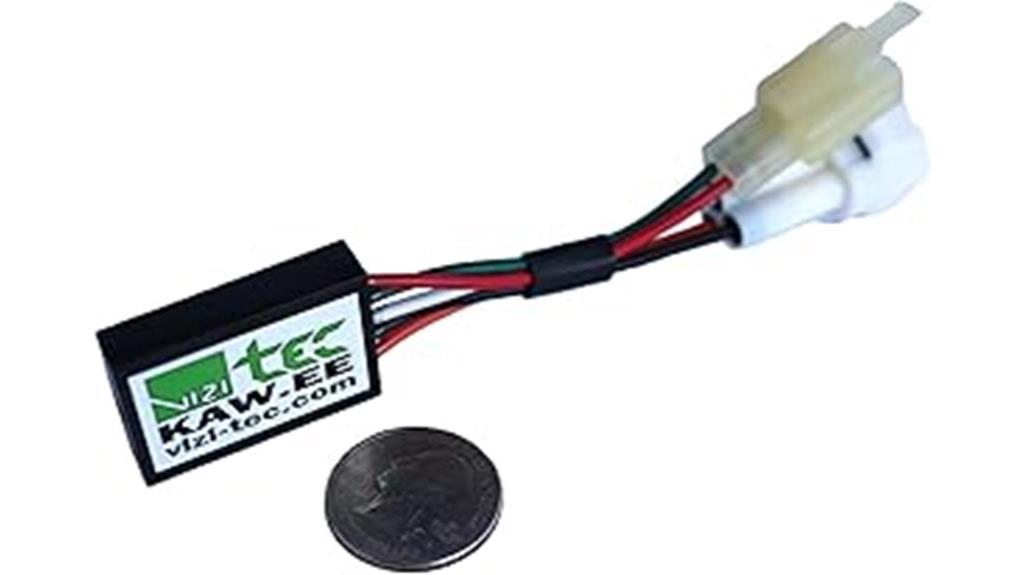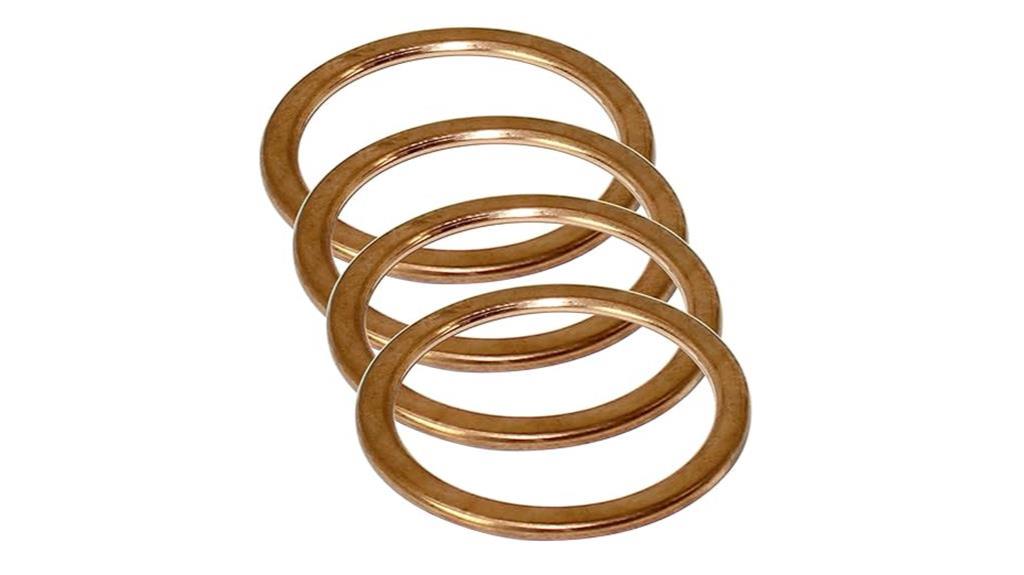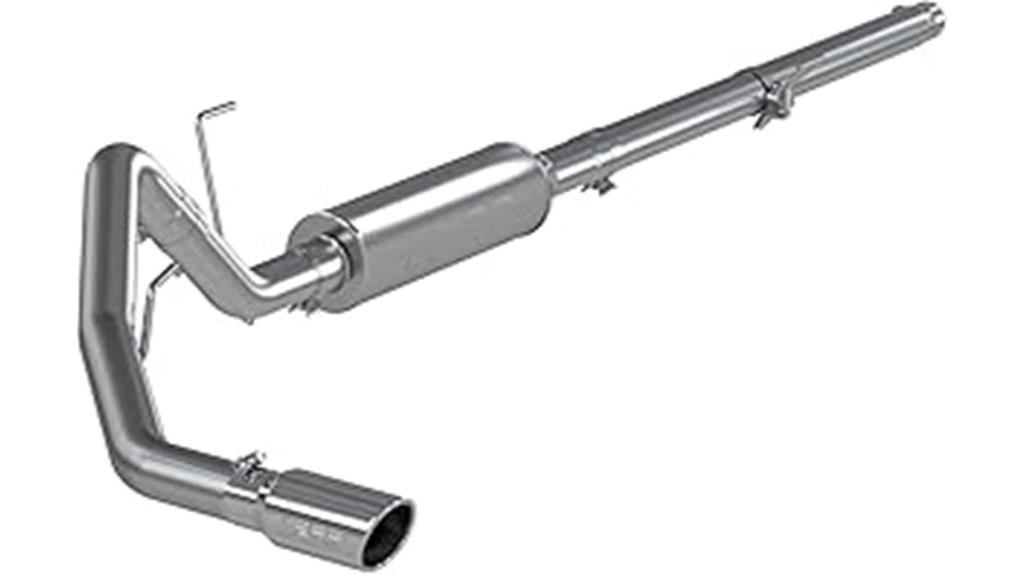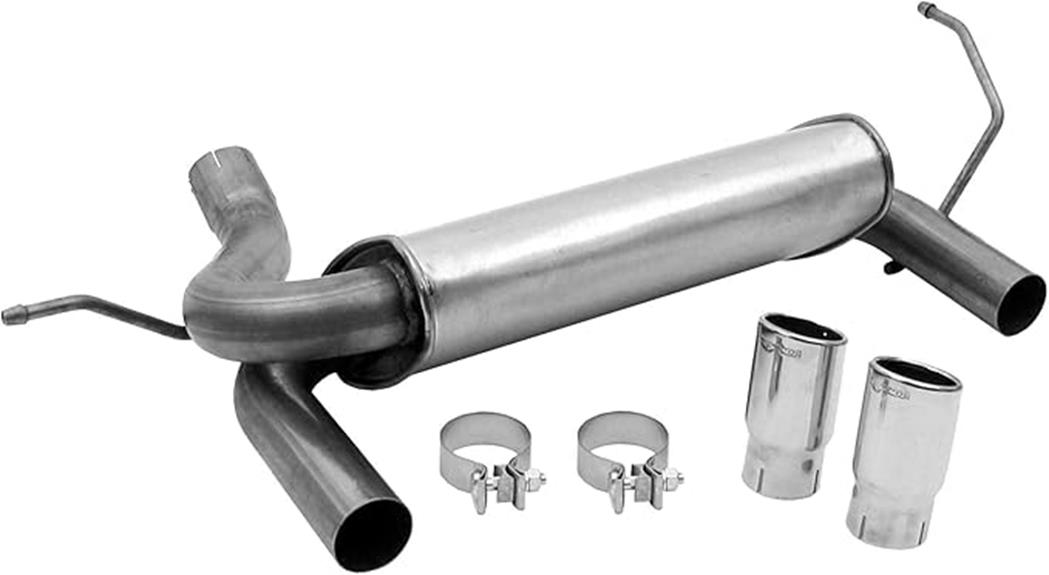Did you know that upgrading your Kawasaki Ninja 300's exhaust system can increase horsepower by up to 10%? It's not just about performance; the right exhaust can also transform your bike's look and sound. With so many options available, narrowing it down to the top choices can be challenging. What factors should you consider to guarantee you get the best blend of power and aesthetics? Let's explore the four standout exhaust systems that can elevate your ride.
Key Takeaways
- The Vizi-tecs Exhaust Servo Buddy enhances performance with easy plug-and-play installation and a lifetime warranty for reliability.
- MBRP S5200AL exhaust system improves throttle response and increases fuel economy while delivering a rich, mellow sound quality.
- Compatibility with specific Kawasaki Ninja 300 model years is essential to ensure proper fit and function of exhaust systems.
- High-performance materials, like stainless steel, provide durability and improved exhaust flow, enhancing overall bike performance and aesthetics.
Vizi-tecs exhaust Servo buddy (Friend) replacement for Kawasaki.

The Vizi-tecs Exhaust Servo Buddy is an ideal choice for Kawasaki Ninja 300 owners seeking a reliable, easy-to-install solution that eliminates check engine lights while enhancing performance.
Weighing just 2 oz and measuring 1.4 × 1.0 × 0.3 inches, this solid-state device fits seamlessly into various Kawasaki models, ensuring compatibility and ease of use. Its plug-and-play installation makes it accessible for riders of all skill levels.
Users appreciate its durable construction, which includes marine-grade epoxy for protection against dirt and moisture. With a lifetime warranty, the Servo Buddy stands out for its long-term reliability.
Boasting a 4.8-star rating from 337 reviews, it's clear that many riders have found success in resolving their check engine issues with this product.
Best For: Kawasaki Ninja 300 owners looking for an easy-to-install solution to eliminate check engine lights and enhance performance.
Pros:
- Simple plug-and-play installation suitable for all skill levels.
- Durable construction with marine-grade epoxy for weather resistance.
Cons:
- Not suitable for fixing error codes that cannot be cleared with stock hardware.
- Limited compatibility with some older models; check beforehand.
Caltric Muffler Pipe Gasket for Kawasaki ZX-6R Ninja (1998-2016)

Designed specifically for Kawasaki ZX-6R Ninja models from 1998 to 2016, the Caltric Muffler Pipe Gasket guarantees a reliable seal and eliminates exhaust leaks effectively.
This product includes four gaskets, part number 11060-1203, ensuring users have enough for a complete installation.
Compatible with several other Kawasaki models, including the Klx250s and Zzr 600, it proves versatile for different bikes.
Users have reported significant improvements, such as resolving ticking noises and eliminating exhaust leaks after installation.
Customer feedback highlights an A++ rating for fast and reliable service, along with praise for the gasket's great fit.
For those in need of aftermarket parts, visiting the Caltric Amazon store offers a wide selection for powersports and mowers.
Best For: Motorcycle enthusiasts looking for reliable and effective exhaust solutions for their Kawasaki ZX-6R Ninja and other compatible models.
Pros:
- Fast and reliable service with A++ customer feedback.
- Great fit ensuring a proper seal and functionality.
Cons:
- Limited to specific Kawasaki models, which may not suit all users.
- Requires proper installation to achieve the best results.
MBRP S5200AL 3 Cat Back, Single Side Exhaust System (Aluminized Steel)

Offering a rich, mellow exhaust note and enhanced performance, the MBRP S5200AL 3 Cat Back Exhaust System is an ideal choice for Kawasaki Ninja 300 owners looking to upgrade their ride.
This system features heavy-duty aluminized steel construction and a polished T304 stainless steel tip, ensuring durability and a sleek appearance. Weighing 48 pounds, it's designed for easy installation with common hand tools and includes all necessary clamps.
Riders can expect improved throttle response, boosted torque, and a 1-2 mpg fuel economy increase. Backed by a 3-year warranty, MBRP provides reliable customer support.
Users generally praise the sound quality, describing it as mean at low RPMs, with minimal drone, making this exhaust system a popular choice among enthusiasts.
Best For: Kawasaki Ninja 300 owners seeking an upgrade to enhance performance and sound quality.
Pros:
- Improves fuel economy by 1-2 mpg and boosts torque and horsepower.
- Easy installation with a bolt-on design and all necessary clamps included.
Cons:
- Some users report installation challenges, including mismatched hangers or missing parts.
- May require cutting the mid-pipe for proper fit in some cases.
Dynomax Super Turbo 39510 Exhaust System Kit for Jeep Wrangler

For Jeep Wrangler enthusiasts seeking enhanced performance, the Dynomax Super Turbo 39510 Exhaust System Kit delivers a remarkable boost of 14 horsepower and improved torque of 12 lb-ft.
This exhaust system, compatible with Jeep Wrangler models from 2007 to 2018, features a durable stainless-steel construction that enhances exhaust flow and reduces turbulence.
The kit includes a DynoMax Super Turbo muffler, 3-inch stainless-steel tips, and necessary clamps for easy installation.
Users appreciate the mellow exhaust tone and the straightforward installation process, though some mention minor alignment issues.
With welded hangers and mandrel bends, this dual exit system not only elevates performance but also adds style to the Jeep Wrangler, making it a solid choice for off-road enthusiasts.
Best For: Jeep Wrangler owners looking to enhance performance and sound with a high-quality exhaust system.
Pros:
- Improves performance with a boost of 14HP and 12 lb-ft of torque.
- Easy installation process with included clamps and welded hangers.
Cons:
- Minor alignment issues reported during installation.
- Sound levels may vary, potentially not meeting all user expectations.
Factors to Consider When Choosing Exhaust Systems for Kawasaki Ninja 300
When choosing an exhaust system for your Kawasaki Ninja 300, you'll want to contemplate several key factors.
Think about compatibility with your bike, the quality of materials, and how easy the installation will be.
Don't forget to weigh the sound performance and the impact of weight and dimensions on your riding experience.
Compatibility With Ninja 300
Ensuring compatibility with your Kawasaki Ninja 300 is vital for selecting the right exhaust system, as various models may have specific requirements that can impact performance and fit. Start by confirming the model year of your bike; some exhaust systems are tailored for specific versions only. This step is significant because using an incompatible system can lead to performance issues.
Next, consider the weight and dimensions of the exhaust system. Heavier or bulkier systems might affect your bike's handling and overall performance, so choose wisely. It's also important to verify that the exhaust can be installed using the existing mounting points without requiring extensive modifications. A straightforward installation saves you time and hassle.
Look for exhaust systems that enhance performance metrics like horsepower and torque. These factors can vary considerably between aftermarket options, so read reviews and specifications carefully.
Material Quality Considerations
Material quality plays an essential role in the performance and longevity of exhaust systems for your Kawasaki Ninja 300.
When choosing an exhaust system, consider materials like stainless steel, which offers superior corrosion resistance compared to aluminized steel. While aluminized steel may come at a lower price, it often can't withstand harsh conditions as effectively, leading to rust and degradation over time.
A high-quality exhaust system typically features a polished finish. This not only enhances the aesthetics of your bike but also provides an extra layer of protection against moisture and road debris.
Pay attention to the construction quality, too. Systems that utilize mandrel bends in the exhaust tubing improve exhaust flow, which reduces back pressure and enhances engine efficiency.
Selecting exhaust systems made from materials that meet or exceed automotive standards is vital, especially for high-performance applications. This guarantees you get a reliable and durable product that can withstand the demands of your Ninja 300.
Always prioritize material quality to boost your bike's performance and guarantee it lasts for years to come.
Installation Ease Factors
Considering installation ease is essential when selecting an exhaust system for your Kawasaki Ninja 300, as it can profoundly impact your overall experience. Many exhaust systems offer a bolt-on installation process, making it straightforward to set up with just common hand tools.
If you're a DIY enthusiast, you'll appreciate plug-and-play options that eliminate the need for modifications or welding, allowing for quicker installations. However, keep in mind that some systems may require adjustments, like cutting the mid-pipe for a proper fit, so not every installation will be hassle-free.
Look for kits that come with clear instructions and all necessary hardware, including clamps and hangers, as this can greatly enhance your installation experience. The overall installation time varies; most users complete the process within 1-2 hours, depending on their mechanical skills and the specific exhaust system.
If you're confident in your abilities, you'll likely enjoy the project. Ultimately, choosing an exhaust system that simplifies installation can make a difference, ensuring you spend less time working on your bike and more time riding it.
Sound Performance Expectations
The sound performance of an exhaust system plays an essential role in enhancing your riding experience on the Kawasaki Ninja 300, as many riders seek a deeper, more aggressive tone that complements the bike's sporty character.
When choosing an exhaust, consider how it improves sound quality by reducing turbulence and promoting smoother exhaust flow. This typically results in a richer, mellower tone at low RPMs, making your ride more enjoyable.
Aftermarket exhaust options often aim to increase volume without introducing excessive drone, striking a balance between performance and comfort. This is especially important if you plan on longer rides, as a loud, droning sound can become tiresome.
The material you choose also impacts sound performance; stainless steel usually offers a more refined sound due to its durability and superior construction.
Weight and Dimensions Impact
When selecting an exhaust system for your Kawasaki Ninja 300, pay close attention to its weight and dimensions, as these factors can greatly influence your bike's performance and handling. A lighter exhaust system can markedly enhance acceleration and agility, allowing you to maneuver with ease. This is especially important if you're aiming for improved cornering capabilities and quicker take-offs.
Compact dimensions are another critical aspect to evaluate. A smaller exhaust system not only fits better but also reduces the chances of interference with other components, making installation smoother. Additionally, a streamlined design can enhance aerodynamics, which minimizes drag and maximizes your bike's efficiency.
Durability is equally essential. Opt for exhaust components that can withstand varying operating temperatures and conditions. This will prevent premature wear and tear, ensuring that the weight and dimensions remain effective throughout your riding experience.
Ultimately, by focusing on these factors, you can choose an exhaust system that not only boosts your Ninja 300's performance but also enhances its overall style and handling.
Price Vs. Value Analysis
Evaluating the price of exhaust systems for your Kawasaki Ninja 300 means balancing upfront costs with the long-term performance benefits you can expect. While it may be tempting to go for the cheapest option, consider how improved horsepower and torque can justify a higher initial investment.
Look at the warranty offered by manufacturers; a longer warranty often reflects their confidence in the product's durability and provides assurance of value over time.
Don't forget to analyze customer reviews and ratings. These can give you insights into user satisfaction and confirm that the exhaust system delivers the promised performance enhancements for the price.
Installation complexity is another factor to keep in mind. If the system requires specialized tools or professional help, this can add to your overall costs.
Finally, consider potential savings on fuel economy that a high-quality exhaust system may provide. These savings can help offset the purchase price in the long run.
Warranty and Support Options
Choosing an exhaust system for your Kawasaki Ninja 300 involves considering warranty and support options that can enhance your ownership experience. A solid warranty can save you from unexpected costs, so look for systems that offer a lifetime warranty. This guarantees long-term protection against defects, giving you peace of mind.
Customer support from the manufacturer is equally important. You'll want a brand that provides in-house assistance for installation questions and troubleshooting. This can make the installation process smoother and help resolve any issues quickly. Additionally, check if the product includes a clear return policy, such as a 30-day satisfaction guarantee. This allows you to return the exhaust if it doesn't meet your expectations.
Before making a decision, review the warranty information in a PDF format if available. This document outlines the terms and conditions of coverage, helping you understand what's included.
Frequently Asked Questions
What Are the Benefits of Upgrading to an Aftermarket Exhaust System?
Upgrading to an aftermarket exhaust system offers several benefits.
You'll experience improved performance, as these systems often enhance airflow and reduce back pressure. This can lead to more horsepower and torque.
You'll also enjoy a lighter system that helps reduce overall weight.
Additionally, aftermarket exhausts can provide a more aggressive sound, giving your bike a unique personality.
Plus, many options allow you to customize your style, making your ride truly yours.
How Does an Exhaust System Affect Fuel Efficiency?
Imagine your bike's exhaust system is like a superhero cape—when it's optimized, it can skyrocket your fuel efficiency!
An efficient exhaust system helps your engine breathe better, reducing back pressure and improving combustion. This means your bike uses fuel more effectively, giving you more miles per gallon.
Can I Install an Exhaust System Myself?
Absolutely, you can install an exhaust system yourself!
If you have basic mechanical skills and the right tools, it's a manageable project.
Start by following the manufacturer's instructions closely, and make sure to gather all necessary equipment beforehand.
Don't forget to wear safety gear.
Take your time, double-check your work, and you'll enjoy the satisfaction of enhancing your bike's performance and sound with your own hands.
Happy wrenching!
What Materials Are Commonly Used in Exhaust Systems?
When you're looking at exhaust systems, you'll find that common materials include stainless steel, aluminized steel, and titanium.
Stainless steel is popular for its durability and resistance to corrosion, while aluminized steel offers a more budget-friendly option.
Titanium is lightweight and high-performance, often used in racing applications.
Each material has its pros and cons, so think about what you need for your bike with regard to performance, weight, and cost-effectiveness.
How Do I Properly Maintain My Exhaust System?
To properly maintain your exhaust system, start by regularly inspecting it for rust, leaks, or damage.
Clean it periodically using a mild soap and water solution to remove dirt and grime.
Check the hangers and clamps for tightness, replacing any that are worn.
You should also consider using a high-temperature sealant on any joints to prevent leaks.
Conclusion
Upgrading your Kawasaki Ninja 300 with the right exhaust system can transform your ride, giving you that thrilling roar and sleek look you crave.
You might worry about the installation process, but imagine effortlessly fitting a lightweight Vizi-tecs Servo Buddy or the impressive MBRP system, both designed for easy setup.
Picture yourself cruising down the road, turning heads as the powerful sound and enhanced performance elevate your biking experience to a whole new level.